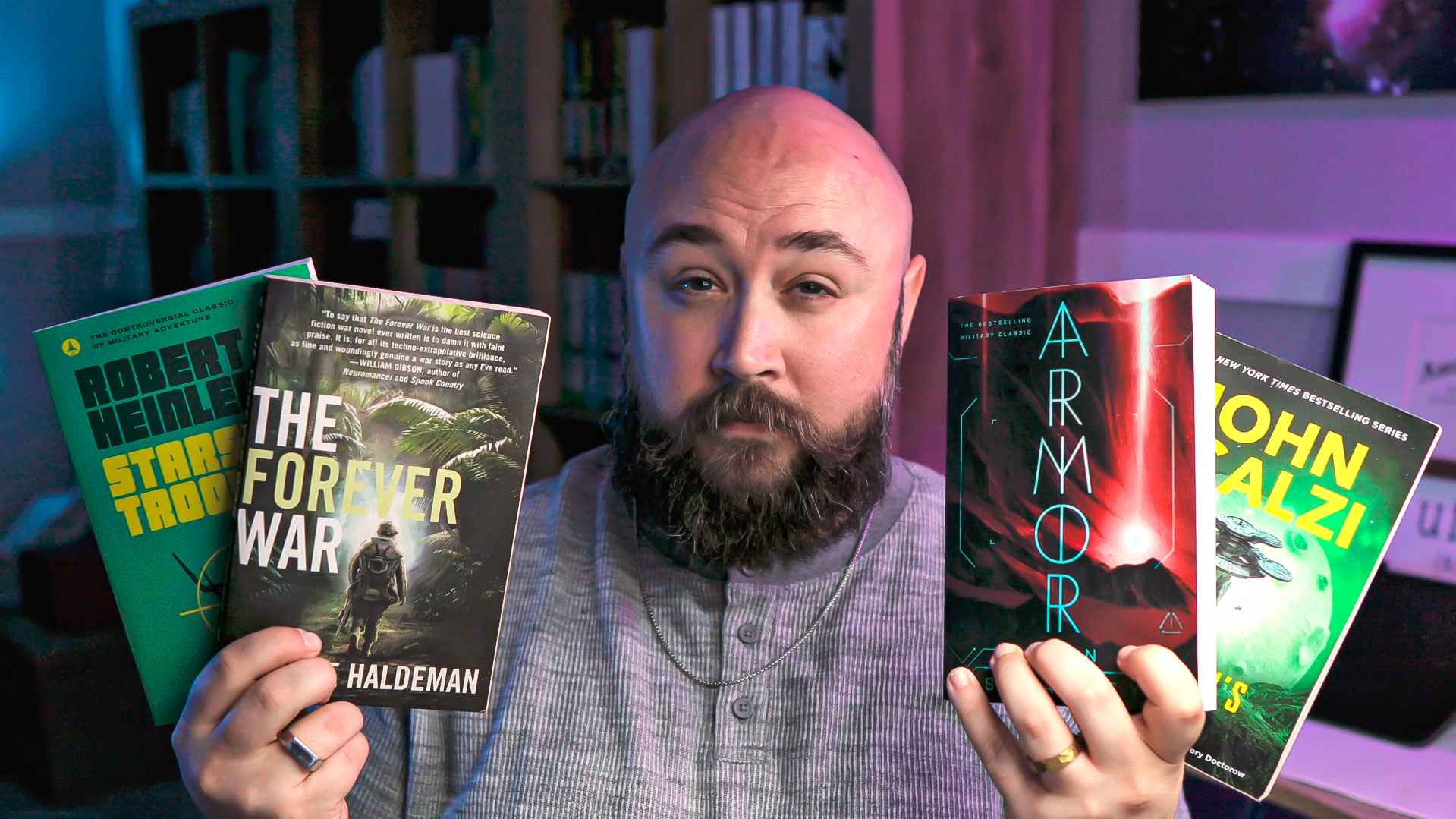There is no shortage of war stories in science fiction. Real-world conflicts are allegorized and translated into grandiose space operas where human bodies are broken or rebuilt or reshaped or turned into something else entirely. Robert Heinlein’s Starship Troopers, Joe Haldeman’s The Forever War, John Steakley’s Armor, and John Scalzi’s Old Man’s War all sit within this strange Venn diagram of speculative fiction: each one takes a different philosophical stance on how war shapes and distorts personal identity. Whether they know it or not, these novels are actually in dialogue with each other, with each book providing a distinct lens through which to view the “war story”: Heinlein with his militaristic idealism, Haldeman with his anti-war disillusionment, Steakley with his existential dread, and Scalzi with his optimistic pragmatism. The protagonists of these novels may all wear futuristic armor and battle scary interstellar threats, but their psychological journeys diverge in ways that reflect not only the historical context of each book but also their authors’ varied philosophical commitments to authority, individual agency, and the nature of identity in times of war.
The Militarized Self: Starship Troopers and the Creation of Identity through Service
Robert Heinlein’s Starship Troopers, which was published in 1959, offers a militaristic view of identity, one where service in the armed forces functions as a rite of passage into full personhood. The protagonist, Johnny Rico, transforms from a callow youth into a hardened soldier, his sense of self becoming fully intertwined with military discipline and duty. In Heinlein’s universe, personal identity is not intrinsic but achieved through rigorous adherence to hierarchical authority and sacrifice for the collective good. Citizenship, in this world, is a reward for military service, implying that only those who serve are worthy of rights and recognition.
Heinlein’s militarism has sparked endless debates—some argue that the book endorses fascism, while others defend it as a nuanced exploration of civic responsibility. Either way, Starship Troopers suggests that war, far from stripping away identity, provides a structure within which identity is forged. The uniform isn’t a loss of individuality but a symbol of purpose, an identity to aspire toward. Rico’s transformation is complete when he no longer questions the system that shaped him; he becomes not just a soldier but a believer, someone who derives his sense of self-worth from his place within the military hierarchy.
The Fragmented Self: The Forever War and the Dislocation of Identity
Joe Haldeman’s The Forever War, published in 1974, was written as a reflection on the author’s experiences in Vietnam, and it presents a radically different view of war and identity. Where Heinlein saw war as a way to achieve personal fulfillment, Haldeman portrays it as a force that fractures identity and alienates soldiers from both themselves and society. William Mandella, the protagonist, returns from the interstellar conflict to find that the Earth he once knew has become unrecognizable. Through relativistic time dilation, centuries pass on Earth while only a few years pass for Mandella, making his reintegration impossible. War for Mandella isn’t a builder of identity; it is a thief that robs him of time, of relationships, and even the language of his native society.
Mandella’s experience reflects the disillusionment of soldiers who return home from war only to find that they no longer belong, and not only that, but often they no longer even recognize the world to which they are returning. Unlike Rico, Mandella does not emerge from the war with a clear sense of self. Instead, he feels adrift, as if the very notion of personal identity has eroded over time. The Forever War presents a world where war doesn’t just kill bodies; it kills continuity, rendering identity fragile and provisional. War isolates the soldier not just from others but from any stable sense of self, a poignant reflection of the alienation that many veterans experience in the aftermath of combat.
Armor and the Disposable Self: The Expendability of Identity
John Steakley’s Armor, published in 1984, takes the metaphor of armor quite literally, using it to explore the psychological mechanisms soldiers adopt to survive trauma. The protagonist, Felix, wears a suit of powered armor that enables him to slaughter alien hordes, but it also becomes a barrier between his humanity and the horrors of war. Felix’s survival depends on the creation of a secondary identity, a relentless killing machine he refers to as “The Engine.” This dissociative split between Felix’s core self and his combat persona reflects the ways in which trauma forces individuals to compartmentalize their experiences.
Steakley’s novel suggests that war requires soldiers to shed their humanity—not just temporarily but permanently. Felix never fully reclaims his original self after the war. His real identity becomes irrelevant; what matters is his ability to survive. Armor explores the idea that war transforms soldiers into expendable machines, stripping them of individuality and replacing it with the cold efficiency of violence. Where Starship Troopers sees identity as something to be built through service, Armor implies that the soldier’s true self must be buried, sacrificed for the sake of survival. What emerges is not a coherent identity at all but a shattered psyche, haunted by the realization that the first casualty of war was the self.
Old Man’s War and the Fluidity of Identity
Finally, John Scalzi’s Old Man’s War, published in 2005, offers a more playful and optimistic take on the relationship between war and identity, though it doesn’t shy away from the psychological complexities involved. In Scalzi’s universe, elderly humans are given new, genetically enhanced bodies to fight in interstellar wars. John Perry, the protagonist, literally gets a new lease on life—his mind transferred into a younger, stronger body designed for combat. This rejuvenation allows Perry to grapple with questions of identity in ways that are both literal and metaphorical: Who are we when our bodies change? Can we still be ourselves when we become something fundamentally different?
Unlike Steakley’s Felix, who loses himself in the machinery of war, Perry retains his sense of humor and moral compass, even as he grapples with the physical and emotional demands of combat. Scalzi’s novel suggests that identity is not fixed but adaptable, capable of surviving profound transformations. The process of becoming a soldier in Old Man’s War involves change, but it does not require the obliteration of the self. Perry’s journey is one of integration—he learns to reconcile his new body and role as a soldier with his memories and values from his former life.
At the same time, Scalzi’s work reflects a certain skepticism toward institutions of power. Perry’s autonomy is constantly at risk, threatened by the military bureaucracy and the demands of war. Yet, Old Man’s War offers the hope that identity can be fluid without being lost—that even in the midst of war, it is possible to remain human.
The Soldier as Everyman: Collective vs. Individual Identity
A key theme that emerges across these four novels is the tension between collective identity and individual selfhood. Starship Troopers champions the idea that personal identity is best realized through service to the collective. In contrast, The Forever War presents the collective as a force of alienation, one that erodes the individual’s sense of self. Armor goes a step further, suggesting that the collective doesn’t just subsume the individual—it annihilates it, leaving only survival mechanisms in its wake. Old Man’s War, however, offers a more nuanced view, positing that individual identity can survive within the collective as long as it remains adaptable.
This tension reflects the authors’ differing philosophical and historical contexts. Heinlein wrote in the shadow of World War II, when the notion of collective sacrifice was celebrated. Haldeman, by contrast, was grappling with the disillusionment of the Vietnam War, where soldiers returned home to find themselves alienated from the society they had fought for. Steakley’s novel, with its focus on psychological trauma, anticipates the more recent discourse around PTSD and the difficulty of reintegration. Scalzi, writing in the post-9/11 era, reflects a world where personal identity is in flux, constantly negotiated between physical realities and virtual possibilities.
War as a Mirror for Identity
Taken together, these four novels reveal the many ways that war reshapes, fragments, and redefines identity. Heinlein’s Rico finds himself through military service, his identity forged in the fires of duty. Haldeman’s Mandella, on the other hand, loses himself in the endless churn of war, his sense of self eroded by time and isolation. Steakley’s Felix discovers that survival comes at the cost of identity, while Scalzi’s Perry learns that identity can survive transformation—but only if it isn’t resistant to change.
War, in these narratives, functions not just as a backdrop but as a crucible for identity. It demands that individuals confront the boundaries of selfhood and decide what can be sacrificed and what must be preserved. Whether war ultimately builds or destroys identity remains an open question, one that each of these novels answers in a different way. The answer, it seems, depends not only on the nature of the war but on the nature of the individual who fights it.
In the end, these novels suggest that identity is both a weapon and a shield. For some, like Rico, it is something to be sharpened through discipline and service. For others, like Mandella and Felix, it is a fragile thing, easily shattered by the violence of war. And for those like Perry, it is a constant work-in-progress, a reminder that even in the darkest moments, the self is never entirely lost—it can always be found again, though perhaps in a new and unexpected form.



